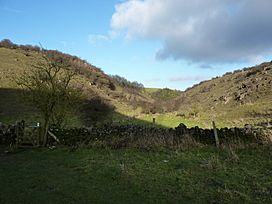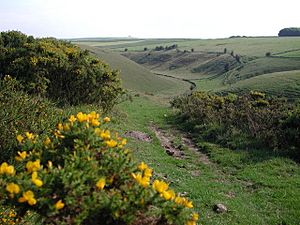Long Dale facts for kids
Quick facts for kids Long Dale |
|
|---|---|
| Long Dale & Gratton Dale | |

Gratton Dale - Long Dale junction
|
|
| Length | 4 kilometres (2.5 mi) NW-SE and SW-NE |
| Width | 250 metres (820 ft) |
| Depth | 50 metres (164 ft) |
| Geography | |
| Location | Derbyshire, England |
| Population centers | Elton |
| Rivers | Rowlow Brook |
Long Dale is a beautiful valley in Derbyshire, England. It's found in the Peak District, a famous national park. This valley is made of a type of rock called carboniferous limestone. It's near a village called Elton.
The valley cuts through areas known as Gratton Moor and Smerrill Moor. It's also close to Pikehall, where the Y Not Festival happens every year. Partway down, the valley makes a sharp turn and is then called Gratton Dale. Most of the valley is dry, but a stream called Rowlow Brook flows through the lower part of Gratton Dale. This brook eventually becomes the River Bradford near Youlgreave.
Contents
Long Dale: A Special Place
Nature's Wonders in Long Dale
Long Dale is part of the Derbyshire Dales National Nature Reserve. This reserve is managed by Natural England. It includes five different valleys in the White Peak area. These valleys are Lathkill Dale, Cressbrook Dale, Hay Dale, Long Dale, and Monk's Dale.
The reserve is home to many different plants. You can find ash and elm trees here. There are also shrubs like hawthorn and elder. Many pretty flowers grow in the dale, including the mountain pansy.
Rare Plants and Grasses
On the old piles of rock from lead mines, you might spot rare flowers. These include spring sandwort (Minuartia verna) and alpine pennycress (Thlaspi alpestre). Native grasses like meadow oat and carnation sedge also grow here. You can also see heather, bilberry, and dwarf gorse.
Long Dale and Gratton Dale together are a special area. They are called a Site of Special Scientific Interest (SSSI). This means they are protected because of their important wildlife and geology.
Ancient History of the Dale
Overlooking Long Dale are some very old burial mounds. These are called the Smerrill Moor, Smerrill Barn, and Long Dale bowl barrows. They are protected as Scheduled Monuments. This means they are important historical sites.
Bronze Age Burial Mounds
These burial mounds date back to the Bronze Age. They are about 10 meters wide. A person named Thomas Bateman dug them up in 1857. He found many human skeletons and tools made of flint. He also found a decorated drinking pot from the Bell Beaker culture.
Old Lead Mines
On the east side of Gratton Dale, you can see the remains of old lead mines. These include Rath Rake, Cowlica Rake, Dunnington, Hardbeat, Hardwork, and Gatcliffe. These mine remains are also a Scheduled Monument.
People have found clues of very old lead mining here. Roman brooches were discovered in Victorian times at Cowlica Rake and Hardbeat mine. Records show that a lot of lead mining happened here since the 1640s. There were even arguments over who owned the mining rights. Today, you can still see old mine shafts, ruined buildings, and earthworks from these mines.
Medieval Farmstead
Just south of Gratton Dale's start are the remains of Mouldridge Grange. This was a farmstead from the Middle Ages. Monks from an Augustinian priory ran this farm. You can still see the earthworks of old buildings and fenced areas. This site is also a Scheduled Monument.
Exploring Long Dale
There is a clear path for walking and riding horses along the valley floor. This path is called a bridlepath. The Pennine Bridleway runs close to Long Dale, about 1 kilometer to the west. Long Dale is also part of a longer trail called the Limey Way. This trail is about 65 kilometres (40 mi) long and connects 20 different valleys in Derbyshire.


